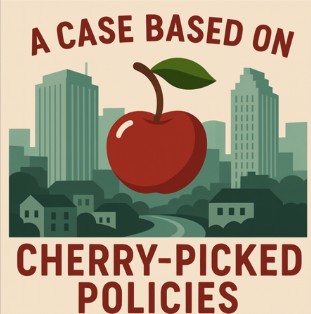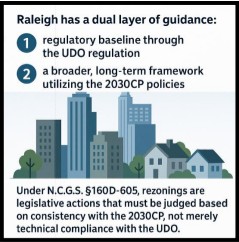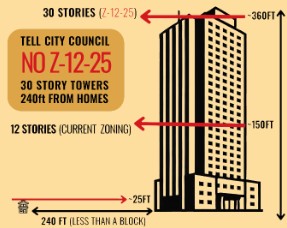
A Raleigh resident for 34 years and a proud homeowner in the historic Glenwood-Brooklyn neighborhood for 24, Roy Attride has been a dedicated neighborhood leader for many years. With a 22-year career in engineering including more than 7 years as a business leader before transitioning into the nonprofit sector in 2021, Roy Attride brings a balanced, solutions-driven perspective to community advocacy.
Passionate about fostering a successful, vibrant, and growing Raleigh, Roy advocates for thoughtful development that engages neighborhoods, supports smart transit and housing solutions, and ensures growth benefits all of Raleigh—not just a select few. Through Livable Raleigh, Roy shares insights, ideas, and advocacy for a Raleigh that thrives through collaboration, inclusivity, and sustainable progress.
We are reprinting this article from Raleigh Neighbors United. It is an analysis of the 2nd Neighborhood Meeting for case Z-12-25, the proposed 30-story West St Tower :
June 25th Developer Meeting Summary, Impacts of Cherry-Picking Policy
Roy Attride (Raleigh Neighbors United)
While the developer’s argument relied on selected pieces of the Comprehensive Plan, it reflected a common rezoning tactic: cherry-picking policies to justify a predetermined outcome.
But when viewed in full context, the city’s adopted plans and policies provide clear, balanced guidance. Below, we break down the developer’s case and the broader policy framework that shows why this rezoning is inconsistent with Raleigh’s vision.

Mr. Attride identifies four areas where the applicant, RDC, uses cherry-picked data to justify the assertion that the proposed rezoning case should be approved. We will address each of the four in separate blogs. In this blog we tackle the Transitions.
-
- Transitions: Misrepresented Compliance
- FLUM and the Central Business District: Misleading Without Context (see previous blog)
- Urban Form Map Designation: Misapplied in the Height Argument (see previous blog)
- Transit Designation: The Claim Doesn’t Hold Up (see previous blog)
4. Transitions: Misrepresented Compliance
RDC’s last point is that they are meeting the guidance on transitions in proposing 20 and 30 story buildings, in a Transition Zone, 240 feet from homes in a Historic Neighborhood. Not only does this not pass a logical assessment it is not fully accurate. If one reviews the 2030CP analysis document and the 21 different policies guiding transition and buffering called out, they would clearly see the policy violations of Z-12-25. Additionally, RDC claims that the UDO codifies the policies on transition and buffers in a text section in 3.5 Land Use Compatibility.
“The Unified Development Ordinance, approved since the initial 2009 publication of this Plan, provides a regulatory framework, including required transition zones and buffers between areas of higher and lower intensities, and between mixed-use and residential properties. The following policies and actions are meant to supplement the Future Land Use Map to ensure that future land uses do not negatively affect existing land uses, and that appropriate transitions are provided between land uses of differing intensity. These policies, particularly those that call for zoning regulations to achieve land use compatibility, have informed and are codified in the Unified Development Ordinance” (2030CP 3.5 Land Use)
However, while the UDO codifies certain aspects of transitions such as when abutting zoning districts trigger setbacks or buffers, the 2030CP offers a broader and more context-sensitive framework for achieving land use compatibility.
The text in Section 3.5 does not suggest that all transition and buffering considerations are confined to what is codified in the UDO. On the contrary, it explicitly states: “The following policies and actions are meant to supplement the Future Land Use Map to ensure… appropriate transitions are provided…”and that these policies “have informed and are codified in the Unified Development Ordinance.” This language makes clear that the 2030CP’s transition policies are meant to supplement both the FLUM and the UDO, not be replaced by them. The Plan precedes and informs the UDO and remains Raleigh’s primary guiding policy document, particularly in the context of rezonings.

Additionally, the UDO does not and cannot govern all transitions in every situation. Specific examples are Historic resources and Transit areas. The 2030CP specifically requires a heightened duty of care at the edges of historic neighborhoods and resources through the following policies LU 5.6 (Buffering Requirements), UD 2.4 (Transitions in Building Intensity), HP 2.6 (Protecting Historic Neighborhoods), HP 2.7 (Mitigating Impacts on Historic Resources) that explicitly call for thoughtful transitions, buffers, and design sensitivity at the edges of historic areas. This goes beyond minimum UDO standards. Similarly, for transit areas, the 2030CP through policies (e.g. LU8.2: Transit Area Transitions) and supporting documents like the Equitable Transit-oriented Development Guidebook (ETOD) provide detailed expectations for transitions in scale, form, and intensity—expectations that are not codified in the UDO but are critical to preserving neighborhood context and achieving equitable, walkable growth. (See ETOD, CBCS, DP Plans Analysis)
The UDO cannot account for every transition need, particularly in sensitive or complex settings such as Z-12-25. This why Raleigh has a dual layer of guidance: 1. regulatory baseline through the UDO regulation and 2. a broader, long-term framework utilizing the 2030CP policies. Rezoning must consider both, and when inconsistencies arise, the Plan’s guidance on compatibility and transitions must be weighed heavily in decision-making. In fact, under N.C.G.S. §160D-605, rezonings are legislative actions that must be judged based on consistency with the 2030CP, not merely technical compliance with the UDO. Many of the Comprehensive Plan’s transition-related policies, especially those concerning height, scale, intensity, and contextual design are not duplicated in the UDO, and remain active and independently applicable.
When evaluating any rezoning request, particularly in sensitive contexts such as exist in Z-12-25 additional 2030CP policies are valid, relevant, and binding even when UDO standards are met. To ignore them would be to disregard the very policy framework that ensures growth happens responsibly, equitably, and in line with Raleigh’s long-term vision.
As we call out in our 2030CP analysis as it relates to Z-12-25, there are 21 different policies (9 major) around height, transition, density and buffering applicable that this rezoning would violate.

This case is about more than just one site, it’s about the future of Raleigh’s neighborhoods and the integrity of our planning process. The developer’s proposal clearly violates adopted plans and policies, relying on selective
interpretations and outdated maps to justify extreme heights in a location where they do not belong. Approving Z-12-25 would set a citywide precedent that threatens neighborhoods across Raleigh, historic or not. We urge residents to stay informed, speak out, and contact City Council because Raleigh’s long-term vision and values are worth defending.
Read Raleigh Neighbors United full report here: June 25th Developer Meeting Summary, Impacts of Cherry-Picking Policy
Roy Attride, Raleigh Neighbors United
The neighbors support the current zoning which allows for 12 stories.
12 stories IS DENSITY
12 stories provides needed housing
Read more about the West St proposal here: Raleigh Neighbors United
NOTE from Livable Raleigh – Mayor Cowell says she is keeping track of her email on the issue of the proposed 30-story tower at West St. If you are opposed to it and want to see Raleigh honor the Comprehensive Plan as Mayor Cowell said we should, then please email the Mayor and ALL the City Council to express your concerns. This email address will send your message to all council members: citycouncilmembers@raleighnc.gov or you can find complete contact information for each councilor and their social media accounts here: City Council Contacts
Stop Z-12-25 West St Tower – Sign the Petition
Growth with Consequences Risk to Neighborhoods
A Threat to Every Raleigh Neighborhood
Height Without Transition Risks Raleigh’s Future
The Impact of Cherry-Picking Policy – Part One
The Impact of Cherry-Picking Policy – Part Two
The Impact of Cherry-Picking Policy – Part Three
The Impact of Cherry-Picking Policy – Part Four
Is West St in the Core of Downtown?
Do City Plans have a Use By Date?
West St Tower Violates Raleigh Downtown Plan
West St Tower Violates Equitable Transit Development
West St Tower Violates the Capital Blvd Corridor Study
West St Tower Proposal Violates the Comprehensive Plan
West St Tower Neighborhood Meeting – All Stand!
Want to know more about these signs?
If you appreciate the kind of reporting we bring to you
|
Please donate $10 or $20, Thanks for supporting |
 |

